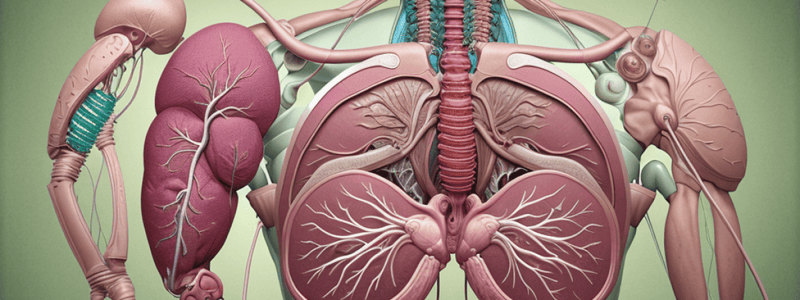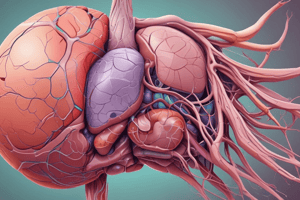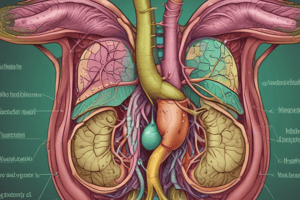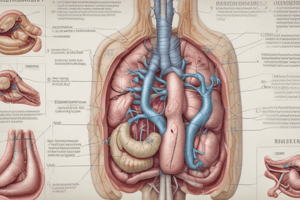Podcast
Questions and Answers
What is the function of the Ampulla of Vater?
What is the function of the Ampulla of Vater?
- To empty bile and pancreatic enzymes into the duodenum (correct)
- To remove bilirubin from the liver
- To drain the liver of bile
- To assist in the production of bile
Which condition presents sonographically with edematous, thickened gallbladder walls?
Which condition presents sonographically with edematous, thickened gallbladder walls?
- Ampulla of Vater
- Cholecystokinin (CCK)
- Choledocholithiasis
- Cholecystitis (correct)
What stimulates the gallbladder to contract and the sphincter of Oddi to relax?
What stimulates the gallbladder to contract and the sphincter of Oddi to relax?
- Bile Ducts
- Choledocholithiasis
- Cholecystectomy
- Cholecystokinin (CCK) (correct)
What is the main portion of the gallbladder referred to as?
What is the main portion of the gallbladder referred to as?
What is the function of bile ducts?
What is the function of bile ducts?
What is the meaning of cholecystectomy?
What is the meaning of cholecystectomy?
Which structure directs bile flow into the gallbladder?
Which structure directs bile flow into the gallbladder?
What is the overall length of a normal gallbladder?
What is the overall length of a normal gallbladder?
Which section of the common bile duct is also referred to as supraduodenal?
Which section of the common bile duct is also referred to as supraduodenal?
What regulates bile flow into the duodenum at the ampulla of Vater?
What regulates bile flow into the duodenum at the ampulla of Vater?
Where does the common bile duct enter the duodenum?
Where does the common bile duct enter the duodenum?
Which structure joins with the pancreatic duct(s) at the ampulla of Vater?
Which structure joins with the pancreatic duct(s) at the ampulla of Vater?
What is the approximate diameter of a normal gallbladder?
What is the approximate diameter of a normal gallbladder?
What is the function of the Common Hepatic Duct (CHD)?
What is the function of the Common Hepatic Duct (CHD)?
What is another term for the Common Bile Duct (CBD) based on its location relative to the duodenum?
What is another term for the Common Bile Duct (CBD) based on its location relative to the duodenum?
What is the maximum volume of bile that a normal gallbladder can hold?
What is the maximum volume of bile that a normal gallbladder can hold?
Where does the CBD continue along after passing posterior to the first portion of the duodenum?
Where does the CBD continue along after passing posterior to the first portion of the duodenum?
What is the typical wall thickness of the gallbladder?
What is the typical wall thickness of the gallbladder?
Which artery perfuses the gallbladder?
Which artery perfuses the gallbladder?
What connects the gallbladder to the common bile duct?
What connects the gallbladder to the common bile duct?
What is the length range of the common hepatic duct?
What is the length range of the common hepatic duct?
What is the typical diameter of the cystic duct?
What is the typical diameter of the cystic duct?
What is the length range of the common bile duct?
What is the length range of the common bile duct?
How is the gallbladder drained?
How is the gallbladder drained?
What is the typical diameter of the common bile duct?
What is the typical diameter of the common bile duct?
Which vein serves as the gateway for venous blood returning from the gastrointestinal tract and accessory organs?
Which vein serves as the gateway for venous blood returning from the gastrointestinal tract and accessory organs?
What is the acceptable size range of the common hepatic duct's diameter?
What is the acceptable size range of the common hepatic duct's diameter?
In which condition can gallbladder walls thicken?
In which condition can gallbladder walls thicken?
What is the function of the Common Bile Duct (CBD)?
What is the function of the Common Bile Duct (CBD)?
What is the role of the Cystic Duct?
What is the role of the Cystic Duct?
Which structure is a small sacculation in the area of the gallbladder neck?
Which structure is a small sacculation in the area of the gallbladder neck?
What is the function of the Hepatic Portal System?
What is the function of the Hepatic Portal System?
What does Cholelithiasis refer to?
What does Cholelithiasis refer to?
What do Liver Function Tests indicate?
What do Liver Function Tests indicate?
What is the purpose of Intrahepatic bile ducts?
What is the purpose of Intrahepatic bile ducts?
What does the Biliary System do?
What does the Biliary System do?
What is the role of Normal Measurements in this context?
What is the role of Normal Measurements in this context?
What does the term 'Extrahepatic' refer to?
What does the term 'Extrahepatic' refer to?
What is the definition of 'Bile'?
What is the definition of 'Bile'?
What is meant by 'Pancreas and Associated Ducts'?
What is meant by 'Pancreas and Associated Ducts'?
What is the role of the rugae inside the gallbladder?
What is the role of the rugae inside the gallbladder?
Which part of the gallbladder resembles a pear shape?
Which part of the gallbladder resembles a pear shape?
What prevents the overdistending or collapsing of the cystic duct?
What prevents the overdistending or collapsing of the cystic duct?
Which structure regulates bile passage into the duodenum and prevents gastrointestinal fluid reflux?
Which structure regulates bile passage into the duodenum and prevents gastrointestinal fluid reflux?
What stimulates gallbladder contraction and duodenal mucosa relaxation, increasing bile production?
What stimulates gallbladder contraction and duodenal mucosa relaxation, increasing bile production?
Which vessels accompany portal veins within the liver?
Which vessels accompany portal veins within the liver?
Where does blood converge into after passing through hepatic sinusoids?
Where does blood converge into after passing through hepatic sinusoids?
What are the three layers of the gallbladder?
What are the three layers of the gallbladder?
Where are hepatic ducts, intrahepatic bile ducts, and hepatic arteries found?
Where are hepatic ducts, intrahepatic bile ducts, and hepatic arteries found?
What role do hepatic sinusoids play in the circulation of blood?
What role do hepatic sinusoids play in the circulation of blood?
What is the primary function of the biliary tract?
What is the primary function of the biliary tract?
What contributes to making the gallbladder appear as anechoic or nearly anechoic on sonography?
What contributes to making the gallbladder appear as anechoic or nearly anechoic on sonography?
What is the function of the Sphincter of Oddi?
What is the function of the Sphincter of Oddi?
Where are the Spiral Valves of Heister located?
Where are the Spiral Valves of Heister located?
Where is the Supraduodenal Common Bile Duct located?
Where is the Supraduodenal Common Bile Duct located?
Where is the Gallbladder located?
Where is the Gallbladder located?
How do bile from the liver reach the gallbladder?
How do bile from the liver reach the gallbladder?
What does an ultrasound visualize in regards to the biliary tract?
What does an ultrasound visualize in regards to the biliary tract?
What is the Main Lobar Fissure?
What is the Main Lobar Fissure?
What components are involved in the biliary and pancreatic systems?
What components are involved in the biliary and pancreatic systems?
What structures form the common bile duct at the liver hilum?
What structures form the common bile duct at the liver hilum?
What is the relationship between Common Hepatic Duct and Right Portal Vein?
What is the relationship between Common Hepatic Duct and Right Portal Vein?
What structures are visualized in FIGURE 15-2?
What structures are visualized in FIGURE 15-2?
What does FIGURE 15-1 illustrate?
What does FIGURE 15-1 illustrate?
Match the following structures with their descriptions:
Match the following structures with their descriptions:
Match the following terms with their meanings:
Match the following terms with their meanings:
Match the following structures with their functions:
Match the following structures with their functions:
Match the following biliary system structures with their locations:
Match the following biliary system structures with their locations:
Match the following biliary system structures with their functions:
Match the following biliary system structures with their functions:
Match the following biliary system terms with their descriptions:
Match the following biliary system terms with their descriptions:
Match the following gallbladder components with their respective measurements:
Match the following gallbladder components with their respective measurements:
Match the following statements with the correct descriptions of gallbladder perfusion and drainage:
Match the following statements with the correct descriptions of gallbladder perfusion and drainage:
Match the following ducts with their variable length and diameter ranges:
Match the following ducts with their variable length and diameter ranges:
Match the following structures with their location in the biliary system:
Match the following structures with their location in the biliary system:
Match the following anatomical features with their function in the gallbladder:
Match the following anatomical features with their function in the gallbladder:
Match the following descriptions with their corresponding anatomical structures in the biliary system:
Match the following descriptions with their corresponding anatomical structures in the biliary system:
Match the following bile duct sections with their alternate names based on location relative to duodenum:
Match the following bile duct sections with their alternate names based on location relative to duodenum:
Match the following structures with their functions:
Match the following structures with their functions:
Match the following descriptions with the corresponding gallbladder measurement:
Match the following descriptions with the corresponding gallbladder measurement:
Match the following structures with their locations or relationships:
Match the following structures with their locations or relationships:
Match the following key words with their definitions:
Match the following key words with their definitions:
Match the following terms with their functions:
Match the following terms with their functions:
Match the following structures with their roles:
Match the following structures with their roles:
Match the following terms with their ultrasound appearance:
Match the following terms with their ultrasound appearance:
Match the following terms with their diagnostic tests:
Match the following terms with their diagnostic tests:
Match the following terms with their descriptions:
Match the following terms with their descriptions:
Flashcards
Sphincter of Oddi
Sphincter of Oddi
Muscle sheath around the common bile duct at the ampulla of Vater; regulates bile flow.
Spiral Valves of Heister
Spiral Valves of Heister
Mucosal folds inside the cystic duct lumen.
Supraduodenal CBD
Supraduodenal CBD
The section of the common bile duct above the duodenum.
Gallbladder Location
Gallbladder Location
Signup and view all the flashcards
Hepatic Ducts
Hepatic Ducts
Signup and view all the flashcards
Biliary Tract
Biliary Tract
Signup and view all the flashcards
Main Lobar Fissure
Main Lobar Fissure
Signup and view all the flashcards
Pancreas & Biliary System
Pancreas & Biliary System
Signup and view all the flashcards
Common Hepatic Duct (CHD)
Common Hepatic Duct (CHD)
Signup and view all the flashcards
Cystic Duct Function
Cystic Duct Function
Signup and view all the flashcards
Common Bile Duct (CBD)
Common Bile Duct (CBD)
Signup and view all the flashcards
Supraduodenal CBD
Supraduodenal CBD
Signup and view all the flashcards
Retroduodenal CBD
Retroduodenal CBD
Signup and view all the flashcards
Infraduodenal CBD
Infraduodenal CBD
Signup and view all the flashcards
Intraduodenal CBD
Intraduodenal CBD
Signup and view all the flashcards
Gallbladder Size
Gallbladder Size
Signup and view all the flashcards
CBD Function
CBD Function
Signup and view all the flashcards
Sphincter of Oddi Function
Sphincter of Oddi Function
Signup and view all the flashcards
Common Hepatic Duct Location
Common Hepatic Duct Location
Signup and view all the flashcards
CBD Location
CBD Location
Signup and view all the flashcards
CHD position
CHD position
Signup and view all the flashcards
CBD Description
CBD Description
Signup and view all the flashcards
Cystic Duct Direction
Cystic Duct Direction
Signup and view all the flashcards
Pancreatic Duct Connection
Pancreatic Duct Connection
Signup and view all the flashcards
Sphincter of Oddi Location
Sphincter of Oddi Location
Signup and view all the flashcards
Sphincter of Oddi Role
Sphincter of Oddi Role
Signup and view all the flashcards
Valves of Heister Details
Valves of Heister Details
Signup and view all the flashcards
CBD Section Location
CBD Section Location
Signup and view all the flashcards
Hepatic Duct Details
Hepatic Duct Details
Signup and view all the flashcards
CHD Position
CHD Position
Signup and view all the flashcards
Study Notes
-
Sphincter of Oddi (Oddi's Muscle): a muscle sheath surrounding the common bile duct (CBD) at the ampulla of Vater, aids in regulating bile flow into the duodenum.
-
Spiral Valves of Heister: mucosal folds within the lumen of the cystic duct.
-
Supraduodenal Common Bile Duct: portion of common bile duct superior to the duodenum.
-
Gallbladder: located on the posteroinferior portion of the right lobe of the liver, not totally surrounded by hepatic tissue, changes location with patient position (left lateral decubitus).
-
Hepatic Ducts: left and right intrahepatic ducts join at the liver hilum to form the common bile duct, proximal portion referred to as common hepatic duct, bile from the liver reaches the gallbladder through hepatic ducts.
-
Biliary Tract: gallbladder, common hepatic duct, common bile duct, pancreatic duct, and duodenum are visualized with ultrasound, located in various areas such as the main lobar fissure, right kidney, and liver.
-
Main Lobar Fissure: a fissure in the liver, the gallbladder is located near it.
-
Pancreas: head of the pancreas, terminal pancreatic duct, and sphincter of Oddi muscle (at the ampulla of Vater) are involved in the biliary and pancreatic systems.
-
FIGURE 15-1 and FIGURE 15-2: illustrations of the biliary system, including the gallbladder, common hepatic duct, common bile duct, and pancreas.
-
Common Hepatic Duct and Right Portal Vein: relationship explained, common hepatic duct is often mistaken as the common bile duct, located anterior to the right portal vein and axial section of the proper hepatic artery.
-
Common Hepatic Duct (CHD): extends inferiorly from liver hilum to gallbladder neck, anterior to right portal vein and proper hepatic artery.
-
Cystic Duct: connects gallbladder to CHD, directs bile flow into the gallbladder.
-
Common Bile Duct (CBD): distal portion of common duct, continues inferiorly along right border of lesser omentum, passes posterior to first portion of duodenum, and enters posteromedial aspect of descending portion of duodenum.
-
CBD: also referred to as supraduodenal, retroduodenal, infraduodenal, or intraduodenal sections based on location relative to duodenum.
-
Gallbladder: overall length varies depending on bile volume, normal size is approximately 8 to 9 cm, and 3 to 5 cm in diameter, holding up to 40 mL of bile, roughly equivalent to 8 teaspoons.
-
CBD: joined to pancreatic duct(s) to form a single duct or remains separate and enters ampulla of Vater, where it empties bile and aids in digestive process.
-
Sphincter of Oddi: surrounds CBD at ampulla of Vater, regulates bile flow into duodenum.
Studying That Suits You
Use AI to generate personalized quizzes and flashcards to suit your learning preferences.




